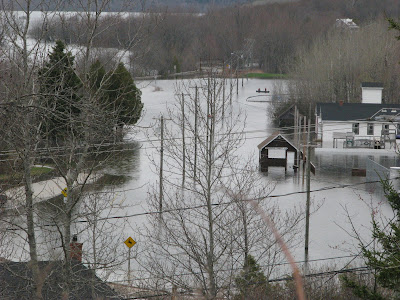Everyone has heard about the earthquake and tsunami that occurred in Japan. And now, the threat from the nuclear plants. We’ve been watching the horrific videos and news broadcasts in regards to this. We all sympathize with the people of Japan.
Hopefully, we will not ever, have to experience such an event as that. Still, it makes us think of our own situations and how prepared are we, in the event of weather emergency in our own areas!
By definition, emergencies happen when we don't expect them, and often when families are not together. If phones don’t work, or some neighbourhoods aren’t accessible, what will you do?
Know the risks
Canada, as well as the USA, are vast countries with extreme weather conditions and dramatic geological features. With their size, weather patterns and varied regions come several natural hazards. Learn about the natural hazards of your country and your region. More importantly, learn how to prepare for them – a natural hazard need not be a natural disaster. Being prepared can make a world of difference.
Get practical information on how to take care of yourself and your family before, during and after an emergency. Learn how to prepare for emergencies caused by natural hazards, and find specific instructions on how to protect yourself and your loved ones in case your region is affected. Read about natural hazard facts and discover where natural hazards can occur in Canada.
Make an emergency plan
The best way to help ensure your family’s safety in these situations is to have an emergency plan. Having a plan, and discussing it with loved ones, will save time and make real situations less stressful.
Learn about the emergencies that can happen where you live and plan for situations that are more likely to occur.
Take a few minutes today and create your family emergency plan.
It will take you about 20 minutes to complete your personalized plan online. Before starting your home emergency plan, you will need to think about:
§ Safe exits from home and neighbourhood
§ Meeting places to reunite with family or roommates
§ Designated person to pick up children should you be unavailable
§ Contact persons close-by and out-of-town
§ Health information
§ Place for your pet to stay
§ Risks in your region
§ Location of your fire extinguisher, water valve, electrical box, gas valve and floor drain
Get a Kit
In case of a major event you will need some basic supplies set aside. That way you will always be prepared to be self-sufficient for at least 72 hours while emergency workers focus on people in urgent need.
Many of the items required in an emergency kit are found in most people's homes. It's just a question of taking some time and putting them together as your emergency kit.
Find out what goes into a basic emergency kit and supplement it with additional emergency supplies. View ourvideo to get started.
Also, drivers could consider packing a basic car kit. You can also find out where to buy an emergency kit.
Get started now – choose one and take a first step to Get Prepared!
Basic emergency kit
You may have some of these basic emergency kit items already, such as a flashlight, battery-operated radio, food, water and blankets. The key is to make sure they are organized, easy to find and easy to carry (in a suitcase with wheels or in a backpack) in case you need to evacuate your home. Whatever you do, don't wait for a disaster to happen.
Easy to carry – think of ways that you can pack your emergency kit so that you and those on your emergency plan can easily take the items with you, if necessary.
· Water – two litres of water per person per day (Include small bottles that can be carried easily in case of an evacuation order)
· Food – that won't spoil, such as canned food, energy bars and dried foods (remember to replace the food and water once a year)
· Manual can opener
· Flashlight and batteries
· Battery–powered or wind–up radio (and extra batteries)
· First aid kit
· Special needs items – prescription medications, infant formula or equipment for people with disabilities
· Extra keys – for your car and house
· Cash – include smaller bills, such as $10 bills (travellers cheques are also useful) and change for payphones
· Emergency plan – include a copy of it and ensure it contains in–town and out–of–town contact information
All of the information on this blog comes directly from the Canadian Government Emergency Preparedness web site: http://www.getprepared.gc.ca/index-eng.aspx
I would encourage you to explore this site for more in depth information on what particular natural disaster you might expect in your own area.
Kathy



Great advice Kathy, I have SOME of the necessary items around the house, but not gathered together, it's not going to do us much good if we can't locate it all quickly. Time for me to get organized!!
ReplyDeleteI too have a lot of the 'stuff' spread out all over the house. But if we get something,like a hurricane or freezing rain or thunder storm, we usually get some notice and, then it give me something to do besides worry.
ReplyDeleteI should at least have a list of where everything is located, so I could find it in a hurry.